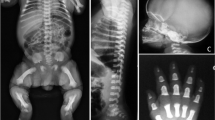Abstract
Background
A radiologic diagnosis of hypochondroplasia is hampered by the absence of age-dependent radiologic criteria, particularly in the neonatal period.
Objective
To establish radiologic criteria and scoring system for identifying neonates with fibroblast growth factor receptor 3 (FGFR3)-associated hypochondroplasia.
Materials and methods
This retrospective study included 7 hypochondroplastic neonates and 30 controls. All subjects underwent radiologic examination within 28 days after birth. We evaluated parameters reflecting the presence of (1) short ilia, (2) squared ilia, (3) short greater sciatic notch, (4) horizontal acetabula, (5) short femora, (6) broad femora, (7) metaphyseal flaring, (8) lumbosacral interpedicular distance narrowing and (9) ovoid radiolucency of the proximal femora.
Results
Only parameters 1, 3, 4, 5 and 6 were statistically different between the two groups. Parameters 3, 5 and 6 did not overlap between the groups, while parameters 1 and 4 did. Based on these results, we propose a scoring system for hypochondroplasia. Two major criteria (parameters 3 and 6) were assigned scores of 2, whereas 4 minor criteria (parameters 1, 4, 5 and 9) were assigned scores of 1. All neonates with hypochondroplasia in our material scored ≥6.
Conclusion
Our set of diagnostic radiologic criteria might be useful for early identification of hypochondroplastic neonates.




Similar content being viewed by others
References
Hicks J (2003) Achondroplasia family of skeletal dysplasia. In: The National Organization for Rare Disorders. Inc., editors. NORD guide to rare disorders. Lippincott Williams & Wilkins, Philadelphia, p 144
Hall BD, Spranger J (1979) Hypochondroplasia: clinical and radiological aspects in 39 cases. Radiology 133:95–100
Matsui Y, Yasui N, Kimura T et al (1998) Genotype phenotype correlation in achondroplasia and hypochondroplasia. J Bone Joint Surg (Br) 80:1052–1056
Appan S, Laurent S, Chapman M et al (1990) Growth and growth hormone therapy in hypochondroplasia. Acta Paediatr Scand 79:796–803
Saito T, Nagasaki K, Nishimura G et al (2012) Radiological clues to the early diagnosis of hypochondroplasia in the neonatal period: report of two patients. Am J Med Genet A 158A:630–634
Bonnefoy O, Delbosc JM, Maugey-Laulom B et al (2006) Prenatal diagnosis of hypochondroplasia: three-dimensional multislice computed tomography findings and molecular analysis. Fetal Diagn Ther 21:18–217
Huggins MJ, Mernagh JR, Steele L et al (1999) Prenatal sonographic diagnosis of hypochondroplasia in a high-risk fetus. Am J Med Genet 87:226–229
Jones SM, Robinson LK, Sperrazza R (1990) Prenatal diagnosis of skeletal dysplasia identified postnatally as hypochondroplasia. Am J Med Genet 36:404–407
Karadimas C, Sifakis S, Valsamopoulos P et al (2006) Prenatal diagnosis of hypochondroplasia: report of two cases. Am J Med Genet A 140:998–1003
Kataoka S, Sawai H, Yamada H et al (2004) Radiographic and genetic diagnosis of sporadic hypochondroplasia early in the neonatal period. Prenat Diagn 24:45–49
Lemyre E, Azouz EM, Teebi AS et al (1999) Bone dysplasia series. Achondroplasia, hypochondroplasia and thanatophoric dysplasia: review and update. Can Assoc Radiol J 50:185–197
Xue Y, Sun A, Mekikian PB (2014) FGFR3 mutation frequency in 324 cases from the International Skeletal Dysplasia Registry. Mol Genet Genomic Med 2:497–503
Le Merrer M, Maroteaux P (1991) Cartilage hair hypoplasia in infancy: a misleading chondrodysplasia. Eur J Pediatr 150:847–851
Acknowledgments
We would like to thank the following associates for their assistance with this study: Norio Shinozuka, MD, Akinori Taguchi, MD, Hidenori Haruna MD, and Kaoru Obinata, MD. This study was supported by the NNPL Growth Hormone Award 2010 and a grant-in-aid for Scientific Research from the Ministry of Health, Labour and Welfare of Japan, H26-Nanchitou (Nan)-Ippan-055.
Author information
Authors and Affiliations
Corresponding author
Ethics declarations
Conflict of interest
None
Rights and permissions
About this article
Cite this article
Saito, T., Nagasaki, K., Nishimura, G. et al. Criteria for radiologic diagnosis of hypochondroplasia in neonates. Pediatr Radiol 46, 513–518 (2016). https://doi.org/10.1007/s00247-015-3518-2
Received:
Revised:
Accepted:
Published:
Issue Date:
DOI: https://doi.org/10.1007/s00247-015-3518-2




